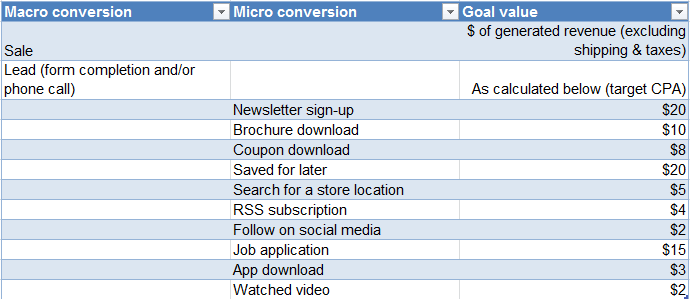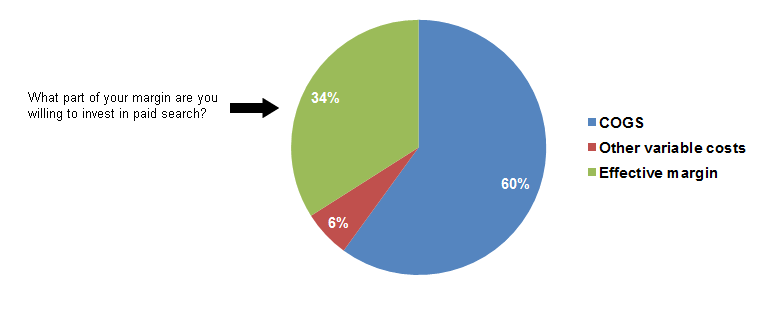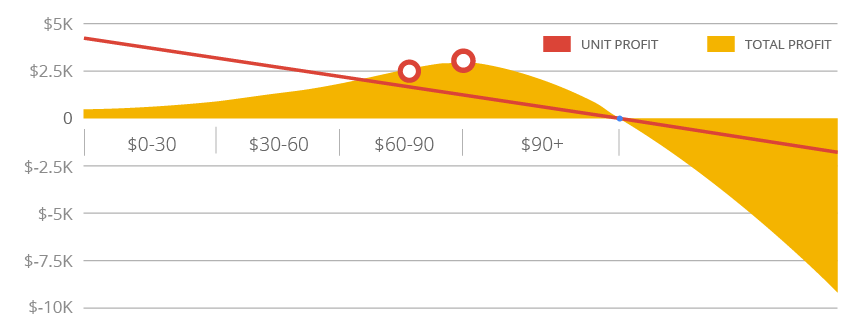You’ll find links to the other chapters at the bottom.
Why do you advertise?
Why do you invest in paid search? This may sound like a strange question if you’ve been doing it for a while, but it really is the question that precedes all others and therefore, where our audit starts. As Simon Sinek says: “Start with why“.
As you will be working towards reaching your goals while optimizing your account and making decisions about keywords, bids, ads, campaign settings and landing pages based upon your goals, you’ll want your goals to be as sophisticated and as closely tied to your business objectives as possible.
When asked why they invest in paid search, people often initially give answers along the lines of “to generate revenue” or “to get new customers”.
Stated as such, these aren’t goals yet. Although they may define the purpose of the campaigns, we can’t use them in our daily optimization as they miss a crucial element: at what price should these goals be achieved?
Assuming you’ll want to run profitable campaigns, you need to find out how much you can invest to achieve each of those goals while still making a profit (or even maximizing profit).
Unfortunately, many advertisers don’t have a complete picture of how actions on their website deliver value to their business. They need your guidance to set better (and usually more) goals.
Beware: they may sputter when you confront them with all the things they haven’t valued (correctly), but this is the time to give some tough love as everything else depends on it, including what the results of your campaigns look like.
So let’s walk through the necessary steps to create specific and profitable goals. By the way: it’s perfectly fine to have multiple goals (just make sure to prioritize them) and to refine them over time.
Economic value on your website
Firstly, make sure you have a clear and complete picture of the ways in which your website generates value for your business.
Online conversions: macro & micro
Is there just one valuable action (conversion) a visitor can perform on your website or are there more? The main conversion on your website is probably a sale or a lead. Those would be the macro conversions.
But there may also be other valuable actions a visitor can perform: the micro conversions. You’ll get a much more complete picture of the total value generated on your website (and with paid search) if you identify micro conversions as well and assign goal values to them (preferably in terms of revenue).
Examples of macro and micro conversions (including example values), to give you an idea:

The value you assign to the micro conversions should be as closely related to the average revenue they’ll eventually generate as possible, or their opportunity cost, like what it would cost you to send a brochure to an interested prospect in the physical world.
For example, if you’re doing e-mail marketing and you know that when you send out a newsletter to 5,000 addresses, this mailing will generate $100,000 in revenue, then you could say that a sign-up is worth $20.
Offline Conversions
If your website (and therefore your campaigns) can also drive orders to the call center and/or offline stores the valuation gets more complex, especially from a measurement standpoint. But this shouldn’t be a reason to ignore these conversions, as doing so may lead you to (greatly) undervalue the results of your online advertising.
I’ll go into the measurement best practices, both online and offline, in the next post about tracking results.
For now, if phone calls or offline purchases are important to you, you should be placing a value on actions on your website that indicate such offline conversions.
Lifetime value
Are the values you assign to conversions based on just one interaction or do you consider the lifetime value (LTV) of a customer? Using the LTV (or at least a longer time value than just the first sale or interaction) will allow you to be more aggressive with your advertising, which means you can reach a greater audience.
Just to give you an idea of how lifetime value could be calculated, see this impressive infographic by KISSmetrics. This demonstrates how LTV increases the value of a new Starbucks customer from $5.90 (average spend per visit) to an LTV of $14,099 (average spend during customer lifespan).
Your calculation doesn’t have to be that complex or far-reaching and you can also find great guidance by Avinash Kaushik in his post on computing lifetime value (including an Excel file to help you make the calculations).
You could even go one step further and try to quantify and incorporate the referral value of happy customers that tell their friends about you.
By including micro conversions, offline conversions and taking the lifetime value into account you will have a much more complete picture of how your website and campaigns are creating value for your business, which will give you an advantage over competitors that are less sophisticated in determining this value.
Efficiency targets in paid search:
AdWords (and Google Analytics) can track click cost (obviously), conversions and the revenue (or goal value) generated. But to know what ratio between advertising costs and generated revenue or number of leads is profitable for you, you also need to know:
- Your effective margin. This is defined as: revenue – COGS (cost of goods sold) – variable cost of the additional order. Make sure you only factor in costs related to generating additional sales/leads, not all your costs, as is clearly laid out in Efficiency targets: don’t short-change your marketing.
- The part of this margin you’re willing to invest in acquiring additional revenue (or leads). This is your biggest strategic decision and obviously, you’ll want to know which percentage will maximize your profits, expressed in real dollars. Some have found that 50% is a good rule of thumb to maximize profits, which could make it a good starting point for you.Higher percentages will enable you to advertise more aggressively and generate more revenue or leads, but at a lower profit per dollar of generated revenue or per lead. Lower percentages will do just the opposite.

So this means your efficiency targets should change whenever one of these two factors (or both) change. Which is why it would be wise to regularly check if your targets are still in line with your margins and the part of the margin you want to invest in advertising. On the other hand, it’s unwise to change your targets too often, as it’s hard to hit a moving target.
As you can’t load your margins into AdWords (you can in sophisticated bid management tools) to directly bid on margin, you’ll have to calculate an efficiency target like CPA or ROAS that will ensure you’ve set a profitable target, considering your margin.
Lead generators or single conversion websites: CPA as an efficiency target
If you have just one conversion (type) with a fixed value, you can work with a CPA (Cost per Acquisition) target, which simply is your total advertising cost divided by the total number of conversions generated.
Other terms for this metric are CPL (Cost per Lead), CPO (Cost per Order) or CPS (Cost per Sale), but it all amounts to the same.
However, if your website generates variable revenue (e-commerce) and/or you have defined multiple conversions with different values (like the micro conversions mentioned before), the best thing would be to work with a ROAS target instead of a CPA target.
Working with multiple CPA’s (e.g. lower CPA’s for lower value interactions and higher CPA’s for higher value interactions) could be a way to refine CPA targets. However, from an optimization standpoint, it’s a bit cumbersome to separate the cost and conversions for each conversion type, as AdWords will show you total cost, total conversions and the average CPA of all conversions.
The only way to see the metrics per conversion type is to use the Segment –> Conversions menu in the AdWords interface. And what do with a keyword that, in terms of CPA, over performs on one conversion type and underperforms on another?
How to calculate a profitable target CPA?
To calculate a profitable CPA target, you’ll need the following data:
- Average profit margin (in $) on the revenue generated by a customer (use lifetime value if possible).
- The part of this margin you’re willing to invest in acquisition.
- The lead to sale conversion rate: what percentage of your leads do actually become paying customers? This can differ greatly per marketing channel and keyword, so try to monitor the quality of your leads for your most important channels and keywords, as each lead is not created equal (so neither should its CPA target be equal). More on this in the next post about measurement.
An example & calculation:
- Average profit margin: $500.
- Part of this margin you’re willing to spend on advertising: 50%.
- Lead to sale conversion rate: 30%.
You get your target CPA by performing the following calculation:
(profit margin x investment in advertising) x lead to sale conversion rate
In this case, that would lead to the following CPA: ($500 x 50%) x 30% = $75
This means that you’re willing to pay up to $75 for a lead generated on your website.
E-commerce or multiple goals: ROAS as an efficiency target
From the moment you can track variable revenue on your website and/or have defined multiple goals with a different value for each goal, you’ll want to use an efficiency target that considers this difference in value for each conversion. There are different names for this metric, but it’s all about the ratio between advertising cost and revenue (or goal value) generated by this same advertising:
Return on Advertising Spend (ROAS): the generated revenue divided by the advertising cost.
Effective Revenue Share (ERS) or Ad Cost to Sales (A/S) ratio: this is simply the inverse of ROAS, which is calculated by dividing the advertising cost by the revenue generated.
I personally prefer ROAS as it’s a column in the AdWords interface (Conv. value / cost) which makes it easier to use in daily optimization. Besides you can also use your target ROAS as a smart bidding strategy.
Oftentimes people and tools (and people that are tools) refer to ROAS as ROI (Return on Investment), but ROI is fundamentally different as ROI = (revenue – cost) / (cost) and ROAS = (ad revenue) / (ad cost). For ROI you should take into account the full cost of marketing (like product cost and agency fees), not just the ad cost.
As we factor in the relevant costs into our ROAS target and AdWords (or Analytics) can’t show you real ROI directly, we’ll use ROAS instead.
How to calculate a profitable target ROAS?
You’ll need the following data to calculate a profitable ROAS target:
- The profit margin (in %) on the revenue generated.
- The part of this margin you’re willing to invest in acquisition.
An example & calculation:
- Profit margin: 40%.
- Part of this margin you’re willing to invest in acquisition: 50%.
You get your target ROAS by performing the following calculation:
1 / (profit margin x investment in acquisition)
In this case, that would lead to the following ROAS: 1 / (40% x 50%) = 500% (or 5.0 or 5:1). This means that for every dollar you invest in paid search, you’ll want at least $5 in revenue.
As ERS or A/S is just the inverse, you get these targets by multiplying your profit margin with the part of this margin you’re willing to invest in acquisition: (40% x 50%) = 20%. This means that you’ll want to invest no more than $0.20 in paid search for every dollar of generated revenue.
What if your margins differ?
You could simply work with the average margin for all your products, but it would be better to work with different ROAS targets (each based on the calculation above) for each of your product categories with different margins.
The account should stay manageable though, so there’s a trade-off between having a perfect ROAS for each product (category) and the time it will take the account manager to steer different keywords on different ROAS targets.
To further complicate things, users don’t always buy what they seek, they might buy something with a very different margin from the product they were looking for.
If you have thousands of products with greatly varying margins and invest heavily in paid search, it might be best to look for a bid management solution that can incorporate your back-end system (with margin data) with AdWords so you can directly bid on margin for each keyword, based on the products it’s selling.
What about volume, budgets and forecasts?
Volume
Of course, a great CPA or ROAS isn’t the only goal, because volume matters as well. You’ll probably be more interested in 1,000 conversions for a CPA of $85 than in 100 conversions for a CPA of $75. And of course, you’d rather have 1,000 conversions for a CPA of $65. But as George Michie states in Maximizing ROI: The Wrong Game: “Volume and efficiency are always at tension.” More of one usually means less of the other.
As you don’t put percentages in the bank, you should manage your budgets and targets in such a way that you maximize total profit, expressed in real dollars, instead of just maximizing ROAS or minimizing CPA, which could actually hurt total profit.
The figure below clarifies this relationship between CPA, unit profit and total profit, and how having a higher CPA could still mean increasing total profit (yes, it’s made by Google).

Budgets and forecasts
If your campaigns generate directly measurable revenue and you have a well-defined profitable CPA or ROAS target, working with fixed budgets doesn’t make a lot of sense. To quote George Michie once again, from The Paid Search Uncertainty Principle: “You can’t control both spend levels and efficiency metrics. The more you predetermine one, the less control you have over the other.
This fundamental law of paid search may be its least understood, as many companies determine an efficiency target and then simultaneously fix a rigid budget for how much they will spend in media.”
So what you should do is place your efficiency targets first and let ad spend rise and fall with the market opportunities. This way, you’ll be able to seize opportunities when conditions are favorable and avoid flushing money down the toilet in order to spend your budget.
Putting the budget first can make sense if your returns are uncertain (brand building) or delayed (lead generation).
If your boss or client can’t let go of this idea of fixed budgets and would also like you to forecast results while you’re at it, please let him or her read Overthrow The Tyranny Of Paid Search Budgets and PPC Agencies Promising/Forecasting Results. If you’re lucky, he or she will better understand the dynamics of paid search and why budgeting and forecasting are often futile exercises in this field of marketing. That way, you can go back to doing work that actually improves results.
Work with non-branded targets
I’ll be short about this one, as there’s already an excellent post out there about the horrors of mixing branded and non-branded results, appropriately called The Bright-Line Divide.
Hopefully, this (very typical) segmentation of branded and non-branded results will quickly convince you that the average of these two segments is the biggest lying average you might have ever seen:

So when defining a CPA or ROAS target, use this target to evaluate and manage your non-branded campaigns, as you have very little control over the volume and conversion rate of branded queries.
However, to prevent undervaluation of your non-branded campaigns, use a proper attribution model to credit non-branded keywords (or display campaigns) that assisted conversions that ended with a branded search query. One such solution is ‘last touch with brains’.
There’s one exception to this rule: your brand name could behave like a competitive term if you’re a manufacturer competing with your own channels (e.g. Sony, Lego, Nike, Adidas).
Let the results from your branded queries guide you: if you see competitive statistics like higher CPC’s, CPA’s (lower ROAS), then you can treat your branded keywords as non-branded competitive terms.
But if you see branded results like in the table above, your brand name isn’t competitive and its results shouldn’t be included in your targets.
Goal Setting: Your Audit Checklist




